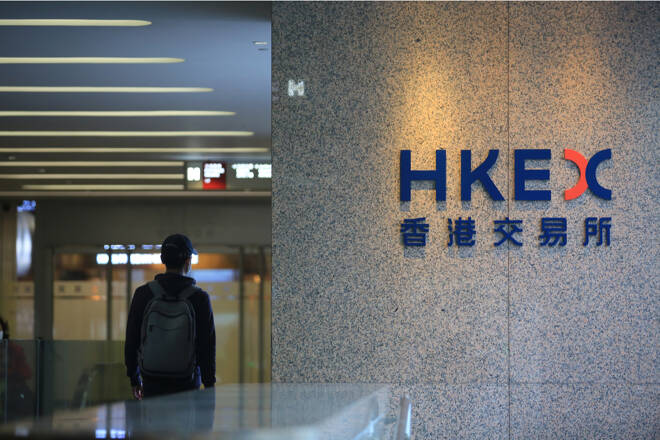Advertisement
Advertisement
Hang Seng Index and Mainland China Markets Fall on Trump Tariff Woes
By:
Key Points:
- Hang Seng dips on US-China tariff fears; tech and property stocks lead losses as tensions rise.
- ASX 200 down 0.90%; mining giants and banking stocks slide amid weak demand and rate cut expectations.
- Japan’s October producer prices spike to 3.4% YoY, but USD/JPY rises as BoJ fuels policy uncertainty.
Nasdaq Ends Five-Day Winning Streak
On Tuesday, November 12, US equity markets ended the session in negative territory. The Dow slid by 0.86%, while the S&P 500 and the Nasdaq Composite Index declined by 0.09% and 0.29%, respectively. Significantly, the Nasdaq ended its five-day winning streak.
Tesla Inc. (TSLA) declined by 6.15% as investors locked in profits before Wednesday’s crucial US CPI Report. The US CPI Report could influence the Fed rate path and the appetite for riskier assets.
Japan’s Producer Prices Spiked in October
On Wednesday, November 13, Japan’s producer prices increased by 3.4% year-on-year in October, up from 3.1% in September. The pickup in producer prices, typically signaling higher demand-driven inflation, failed to fuel demand for the Japanese Yen. Japanese Yen weakness likely contributed to the upswing in producer prices.
Notably, the BoJ is more focused on domestic demand and wage growth than rising import prices despite previous concerns about the effect of a weak Yen on import costs. The USD/JPY advanced 0.12% to 154.779 on Wednesday morning as investors brushed aside the data.
Aussie Wage Growth Slows in Q3 2024
Aussie wage growth also drew interest on Wednesday, rising by 3.5% in Q3 2024, down from 4.1% in Q2 2024. Slower wage growth could impact consumer spending and the Aussie economy as it contributes over 50% to GDP. However, slower wage growth could fuel speculation about an RBA rate cut as inflationary pressures cool.
AMP Head of Investment Strategy and Chief Economist Shane Oliver remarked on the wage growth figures, stating,
“While Aust wages grth is slowing the good news is that inflation has too & so real wage grth has picked up to 0.7%yoy. The bad news is that since the end of 2020 the level of prices (ie the CPI) is up 19% & the level of wages is up just 13%!”
Hang Seng and Mainland China Equities Drop on US Tariff Jitters
In Asian markets, the Hang Seng Index fell 0.49% on Wednesday morning. Market concerns about looming US tariffs on Chinese goods and a potential escalation in US-China tensions impacted buyer demand for HK and Mainland China-listed equities.
Real estate and tech stocks continued falling despite Beijing’s recent policy measures to bolster the Chinese economy.
The Hang Seng Mainland Properties Index and the Hang Seng Tech Index slid by 1.88% and 1.03%, respectively. Among the tech giants, Tencent (0700) declined by 1.24%, while Alibaba (9988) and Baidu (9888) posted losses of 0.06% and 0.36%, respectively.
Mainland China’s equity markets also declined in the morning session. The CSI 300 and the Shanghai Composite were down 0.14% and 0.08%, respectively.
Nikkei Tracks the Broader Market into Negative Territory
Japan’s Nikkei Index slid by 1.07% on Wednesday morning despite a weaker Japanese Yen. Following this morning’s producer price figures, uncertainty about the BoJ’s timing for an interest rate hike likely contributed to the losses.
Softbank Group Corp. (9984) declined by 0.63%, while Sony Corp. (6758) was down 0.87%.
ASX 200 Declines Amid Banking and Mining Weakness
The ASX 200 Index dropped 0.90% on Wednesday morning, marking a potential three-day losing streak. Banking and mining stock losses overshadowed gains for gold-related stocks, leaving the Index in negative territory.
Mining giants Rio Tinto Ltd. (RIO) and BHP Group Ltd. (BHP) fell 2.77% and 1.34%, respectively. Iron ore spot moved sideways this week after Friday’s pullback, with concerns about Trump tariffs on China impacting price trends.
Commonwealth Bank of Australia (CBA) and National Australia Bank (NAB) saw losses of 0.95% and 1.39%, respectively. ANZ (ANZ) was down 3.90% after going ex-dividend.
Demand for Aussie banks waned despite CBA beating earnings forecasts. Speculation about the RBA delaying interest rate cut impacted demand for bank stocks. A higher-for-longer RBA rate path could dampen demand for loans and impact earnings.
Looking Ahead
Investors should keep an eye on stimulus-related chatter from Beijing. Fresh stimulus measures focusing on consumer demand could boost market risk sentiment. Investors should also consider central bank commentary amid shifting sentiment toward BoJ and RBA policy goals. Stay informed with our latest updates for market insights.
About the Author
Bob Masonauthor
With over 28 years of experience in the financial industry, Bob has worked with various global rating agencies and multinational banks. Currently he is covering currencies, commodities, alternative asset classes and global equities, focusing mostly on European and Asian markets.
Did you find this article useful?
Latest news and analysis
Advertisement
